Introduction to AI Models
AI model types are at the core of artificial intelligence, enabling machines to perform tasks that traditionally required human intelligence. These types of AI models process large volumes of data, learn from patterns, and make predictions or decisions based on that learning.
In this section, we will explore what an AI model type is, how different types of AI models work, and their importance in real-world applications. We will also clarify the distinction between AI model types, machine learning, and deep learning.
As you explore the foundations and practical applications of different AI model types, it’s important to consider how these models are put into action within real-world solutions. For organizations looking to turn advanced AI concepts into scalable, production-ready products, discover how AI-assisted software development can help bridge the gap between theory and impactful business results.
What is an AI Model?
An AI model refers to an algorithm or mathematical structure that is designed to perform intelligent tasks such as recognition, prediction, or decision-making. These models are trained on vast datasets and adjust their parameters to learn patterns. The model’s ability to adapt and improve over time allows it to replicate cognitive processes that were previously exclusive to humans.
For example, an AI model used in natural language processing can understand and generate human-like text after being trained on extensive textual data.
How AI Models Work
AI models work by learning from data through a process called training. During training, an AI algorithm is exposed to large datasets and refines its internal parameters to make accurate predictions or decisions.
For instance, a supervised learning model uses labeled data to train the algorithm to predict outcomes based on the patterns it identifies. Once trained, the model can apply this knowledge to new, unseen data and generate results based on its learned understanding.
Did you know? How to Create an AI Model for Your Business
Importance of AI Models in Real-world Applications
AI models are transforming industries by automating tasks, increasing efficiency, and providing insights that were previously difficult to uncover. In healthcare, for example, AI models can analyze medical images to detect diseases at an early stage, improving patient outcomes. In finance, they help in fraud detection and risk management by quickly analyzing large amounts of transactional data. The versatility of AI models makes them invaluable in a wide range of sectors, driving innovation and solving real-world problems.
Difference Between AI, Machine Learning, and Deep Learning Models
AI, machine learning, and deep learning are terms often used interchangeably, but they represent different concepts in the field of artificial intelligence.
- AI refers to the broad goal of machines mimicking human intelligence.
- Machine learning, a subset of AI, focuses on building models that can learn from data and make predictions without being explicitly programmed.
- Deep learning, a further subset of machine learning, uses neural networks with many layers to analyze large and complex datasets, excelling in tasks like speech recognition, image analysis, and autonomous driving.
Broad Categories of AI Models
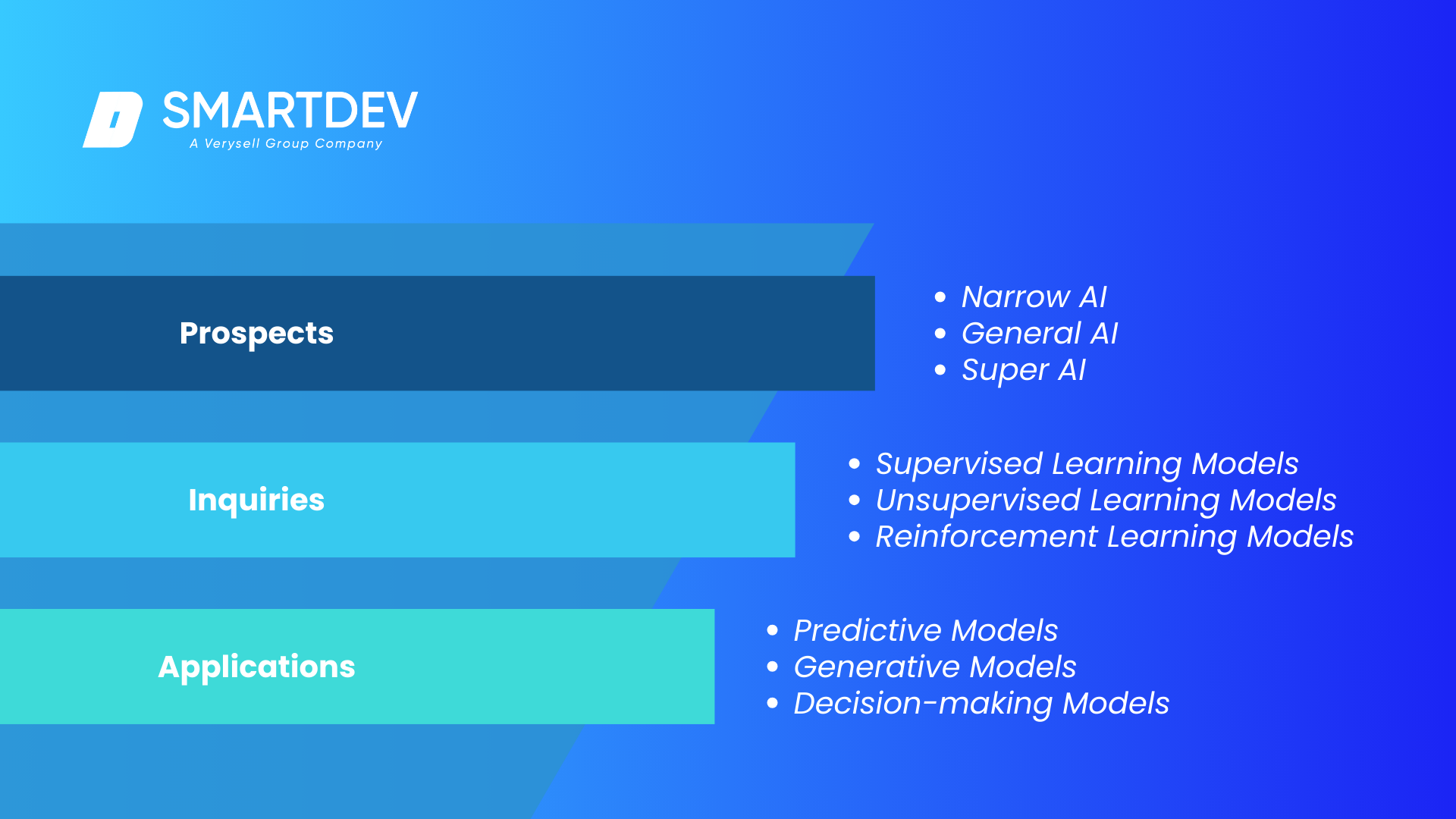 In this section, we will explore the broad categories of AI model types that form the foundation of artificial intelligence. These models can be classified based on their overall approach, learning methods, and specific applications.
In this section, we will explore the broad categories of AI model types that form the foundation of artificial intelligence. These models can be classified based on their overall approach, learning methods, and specific applications.
Understanding these categories helps in selecting the most appropriate types of AI models for various tasks, from prediction to decision-making.
Keep reading!
1st Level: AI Types
AI models are often categorized into three main types: Narrow AI, General AI, and Super AI.
- Narrow AI: This is the most common type of AI today, focused on performing specific tasks like facial recognition or voice assistants. It excels in one area but lacks the ability to perform tasks outside its specialized domain.
- General AI: Unlike Narrow AI, General AI can perform any intellectual task that a human can do. It’s a more advanced and flexible type, but it remains largely theoretical at this stage.
- Super AI: The most advanced type, Super AI surpasses human intelligence across all tasks. This level of AI is still conceptual and has not yet been realized.
2nd Level: AI Learning Approaches
AI models can also be categorized based on their learning approach, which dictates how they process and learn from data.
- Supervised Learning Models: These types of AI models are trained on labeled datasets, where the correct output is already known. The model learns to predict outcomes based on input-output pairs, making them ideal for tasks like spam detection or stock price prediction.
- Unsupervised Learning Models: These models identify patterns or structures in data without labeled output. They are used in clustering, anomaly detection, and dimensionality reduction tasks, making them useful for customer segmentation and fraud detection.
- Reinforcement Learning Models: Reinforcement learning involves training models to make decisions by interacting with an environment and receiving feedback. It’s widely used in autonomous systems, such as self-driving cars or robotic control.
3rd Level: AI Model Applications
AI models can be further categorized by their specific applications, which include predictive, generative, and decision-making models.
- Predictive Models: These types of AI models are used to predict future outcomes based on historical data. They are commonly applied in fields such as finance (for credit scoring) and healthcare (for disease prediction).
- Generative Models: These models generate new data that mimics the original dataset. Applications include AI-generated art, text (such as GPT), and music.
- Decision-making Models: These models assist in making decisions based on input data. They are applied in a variety of domains, including business (for strategy formulation) and healthcare (for treatment recommendations).
By understanding these broad AI model types, businesses and developers can better tailor their AI strategies to meet specific needs and objectives.
Supervised Learning AI Models
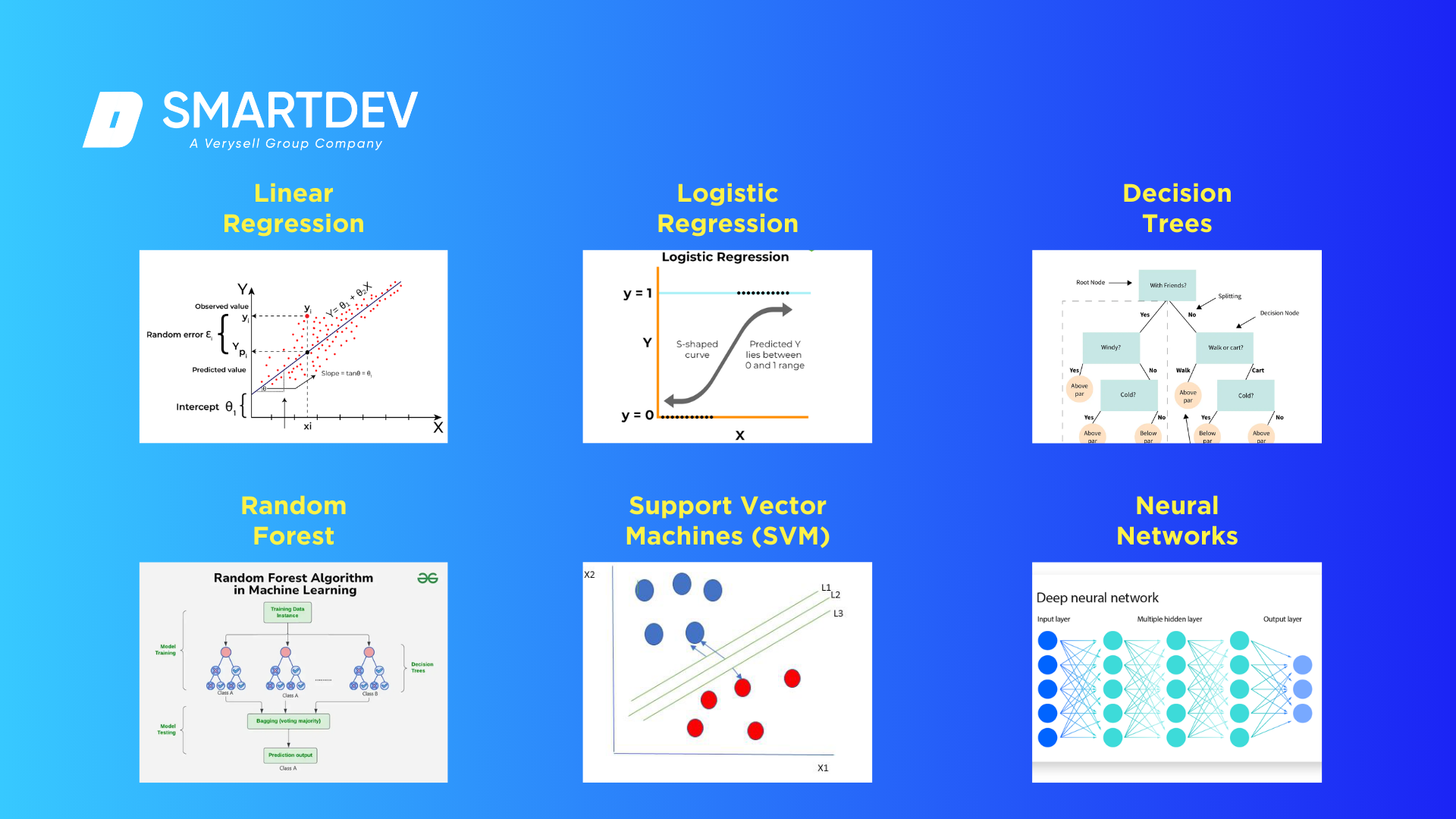 Supervised learning is one of the most widely used AI model types today. These models are trained on labeled datasets, where the correct output is already provided.
Supervised learning is one of the most widely used AI model types today. These models are trained on labeled datasets, where the correct output is already provided.
The goal is for the model to learn the relationship between inputs and their corresponding outputs, enabling it to make predictions or classifications on new, unseen data.
Here, we will explore some of the most common types of AI models used in supervised learning.
Linear Regression
Linear regression is one of the simplest and most commonly used AI model types for predicting continuous values. It finds the relationship between dependent and independent variables, making it particularly useful for applications like predicting house prices based on factors like size and location. By establishing a linear relationship, this model can make predictions based on historical data.
Logistic Regression
Logistic regression is used for binary classification tasks, where the output is limited to two categories. A typical application is spam detection in emails, where the model classifies messages as either “spam” or “not spam” based on features like keywords and sender information. While it’s called “regression,” logistic regression is used for classification because it outputs probabilities.
Decision Trees
Decision trees are a versatile AI model type used for both classification and regression tasks. They split data into branches based on different features, creating a tree-like structure. In customer segmentation, for example, decision trees can help divide customers into groups based on behaviors or demographics, providing actionable insights for targeted marketing strategies.
Random Forest
Random Forest is an ensemble method that combines multiple decision trees to improve accuracy and reduce overfitting. It works by building several decision trees and aggregating their results, making it ideal for tasks like credit scoring, where predictions are made based on various financial factors. This AI model type is robust and effective for handling complex datasets with multiple variables.
Support Vector Machines (SVM)
Support Vector Machines (SVM) are powerful classification models used for tasks like image recognition. They work by finding the optimal hyperplane that separates data into distinct classes. For example, in image classification, SVM can distinguish between different objects or patterns by analyzing pixel data, making it highly effective for facial recognition and object detection tasks.
Neural Networks (ANN, CNN, RNN)
Neural networks are complex AI model types designed to simulate the human brain’s structure. These models consist of layers of interconnected nodes, or “neurons,” which process information and learn from data.
- Artificial Neural Networks (ANN) are used for tasks like predictive analytics and pattern recognition.
- Convolutional Neural Networks (CNN) specialize in image processing, making them ideal for tasks such as facial recognition or object detection.
- Recurrent Neural Networks (RNN) are used for sequential data, such as speech recognition or natural language processing, due to their ability to remember previous inputs in a sequence.
These supervised learning AI model types are the backbone of many real-world applications, enabling machines to learn from labeled data and make highly accurate predictions across various domains.
Unsupervised Learning AI Models
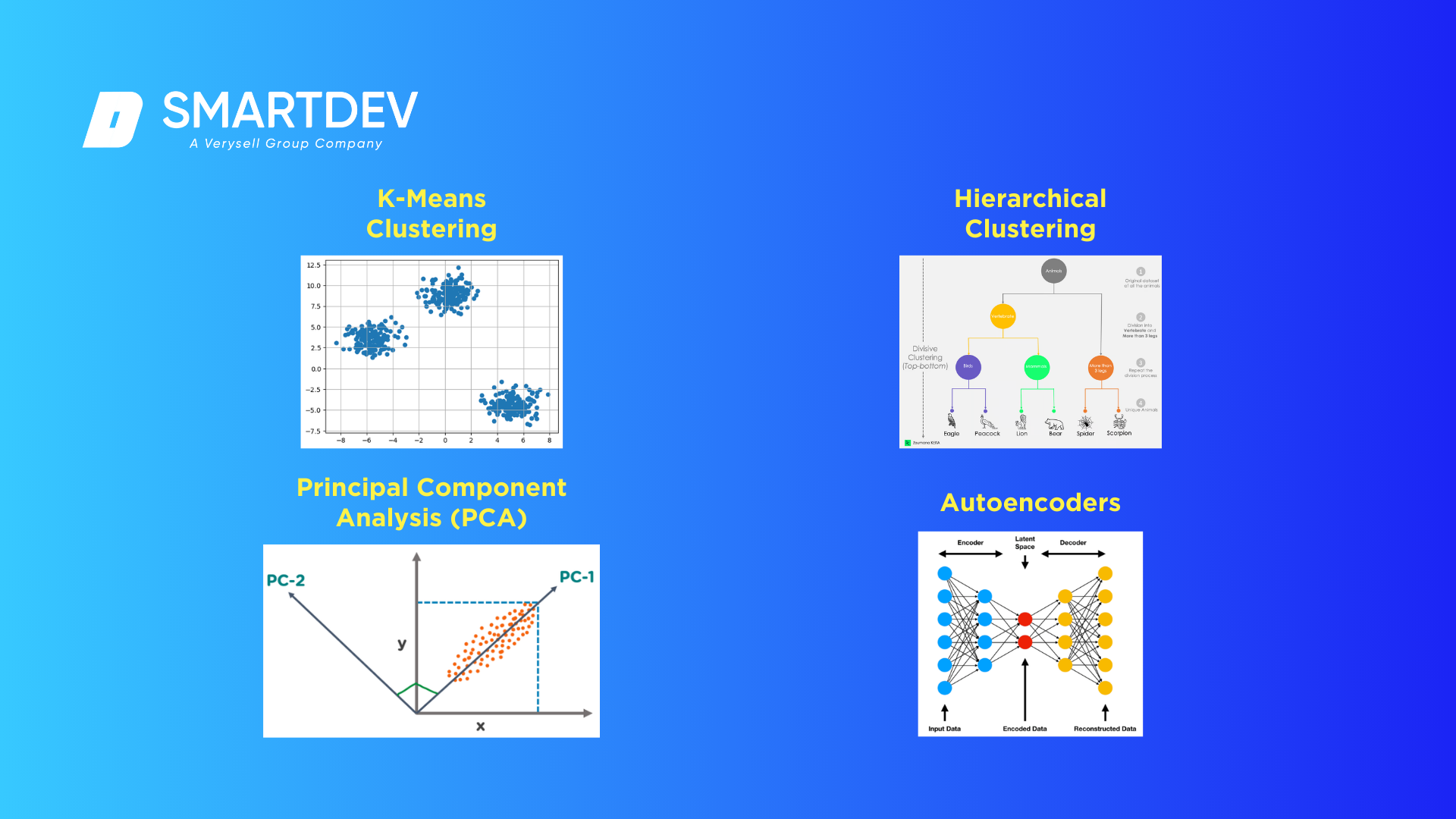 Unsupervised learning is a powerful AI model type used to identify patterns and relationships within datasets that are not labeled. These models work by analyzing input data and discovering inherent structures or groupings, making them ideal for tasks like clustering and anomaly detection.
Unsupervised learning is a powerful AI model type used to identify patterns and relationships within datasets that are not labeled. These models work by analyzing input data and discovering inherent structures or groupings, making them ideal for tasks like clustering and anomaly detection.
In this section, we will explore some of the most commonly used types of AI models in unsupervised learning.
K-Means Clustering
K-Means clustering is a widely used AI model type for grouping similar data points into clusters. The algorithm partitions data into a predefined number of clusters based on their similarities.
A common application is customer segmentation, where K-Means can categorize customers based on behaviors such as purchasing patterns or demographics, helping businesses personalize marketing efforts and improve customer targeting.
Hierarchical Clustering
Hierarchical clustering is another popular AI model type for organizing data into a tree-like structure. It begins by treating each data point as its own cluster and progressively merges them based on similarity.
This approach is useful for tasks like organizing medical data, where hierarchical clustering can group patients with similar health conditions, making it easier to analyze and draw insights from large datasets.
Principal Component Analysis (PCA)
Principal Component Analysis (PCA) is a dimensionality reduction technique that simplifies large datasets while preserving key information. By reducing the number of variables, PCA helps improve the efficiency of other models and visualization tools. It is commonly used in fields like image processing and finance, where it can reduce the complexity of data without losing essential details.
For example, PCA is often applied to reduce the number of features in datasets for machine learning tasks, such as facial recognition.
Autoencoders
Autoencoders are neural networks used for anomaly detection by learning how to compress and reconstruct data. These models are particularly useful in cybersecurity, where they can detect unusual patterns that may indicate a security breach. By training on normal data, autoencoders can flag instances that deviate from the expected, making them ideal for identifying fraud, network intrusions, or other anomalies in real-time.
Tip: To ensure these models perform effectively and reliably, it’s crucial to follow best practices in AI model testing—especially when applied in high-stakes environments like cybersecurity.
These unsupervised learning AI models are valuable tools for uncovering hidden patterns, reducing data complexity, and detecting anomalies, making them essential for a wide range of applications across various industries.
Reinforcement Learning AI Models
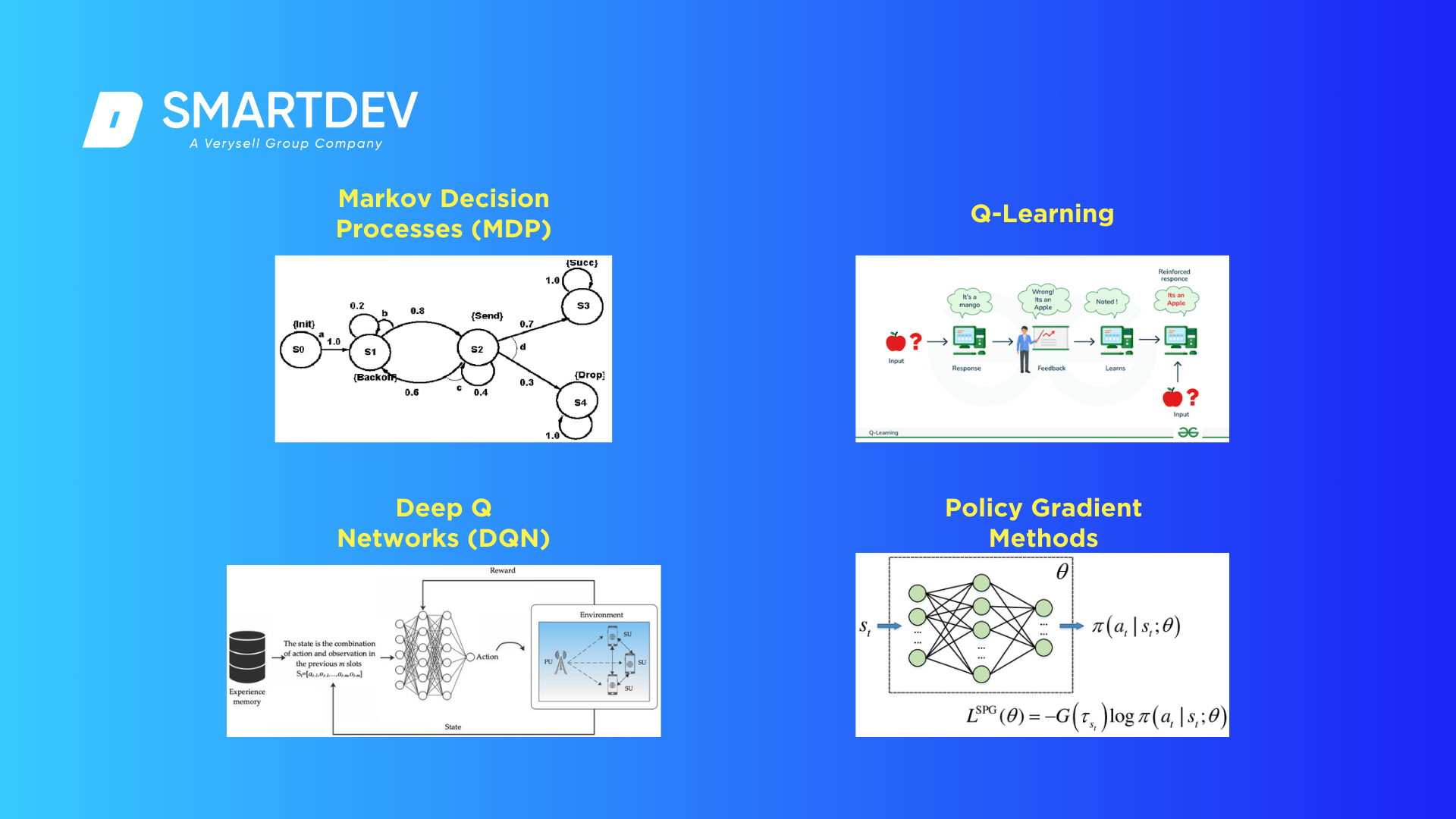 Reinforcement learning is a type of AI model focused on enabling autonomous decision-making through interactions with an environment.
Reinforcement learning is a type of AI model focused on enabling autonomous decision-making through interactions with an environment.
Unlike supervised and unsupervised learning, reinforcement learning models learn by trial and error, receiving feedback in the form of rewards or penalties. This makes them ideal for applications where decisions need to be made based on ongoing interactions, such as robotics or autonomous vehicles.
In this section, we explore some of the most commonly used types of AI models in reinforcement learning.
Markov Decision Processes (MDP)
Markov Decision Processes (MDP) are a fundamental AI model type used to model decision-making problems where outcomes are partially random and partially under the control of the decision-maker.
MDPs are particularly useful for simulating financial markets, where decision-making involves uncertainty and changing states. In these models, decisions are made based on the current state, and the model evaluates the rewards or costs of actions to optimize future decisions.
Q-Learning
Q-learning is a model-free reinforcement learning algorithm used to learn the value of actions in an environment. It is widely known for applications like game-playing AI such as AlphaGo, where the model learns the optimal moves by interacting with the game environment and adjusting its strategy based on the outcomes of previous actions.
By estimating the best action to take at each state, Q-learning enables autonomous decision-making in complex, dynamic environments.
Deep Q Networks (DQN)
Deep Q Networks (DQN) combine Q-learning with deep neural networks to handle more complex decision-making environments. DQN is especially useful in scenarios with high-dimensional data, such as self-driving cars. It allows the model to process images or sensor data from the car’s environment and make decisions in real-time.
DQN is capable of learning complex policies, such as navigating through traffic or avoiding obstacles, making it a powerful tool for autonomous systems.
Policy Gradient Methods
Policy gradient methods focus on directly optimizing the decision-making policy by adjusting the parameters of the policy network. These AI models are particularly useful in robotics and control systems, where the model needs to continuously improve its performance based on feedback from the environment. In applications such as robot arm manipulation or drone flight, policy gradient methods allow for continuous learning and fine-tuning of actions to achieve optimal control over tasks.
Reinforcement learning AI models are central to applications that require autonomous decision-making, where models must continuously adapt and learn from their environment. These models are driving innovations in fields like robotics, autonomous driving, and real-time strategic decision-making.
Deep Learning AI Models
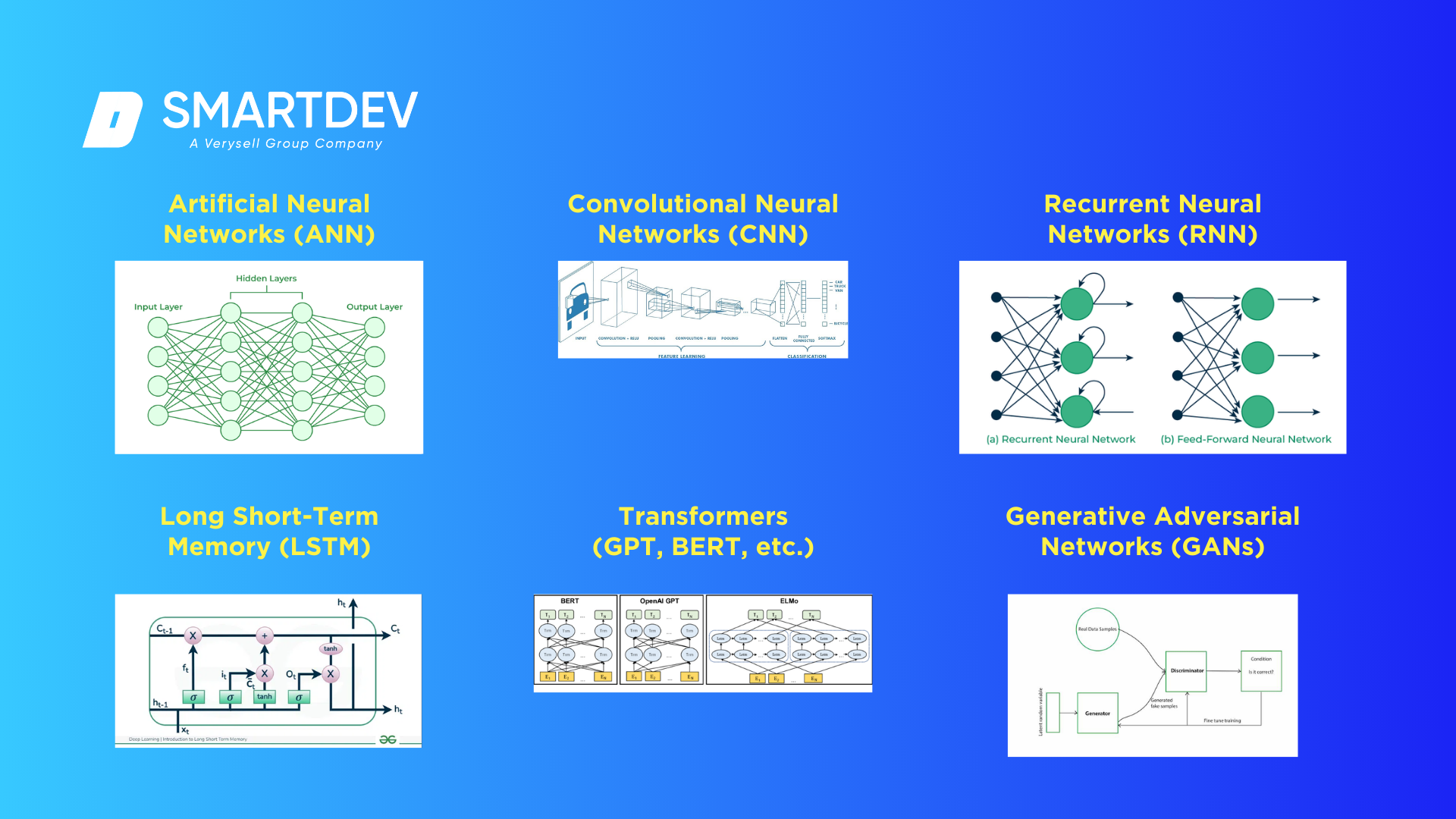 Deep learning, a subset of machine learning, leverages complex neural networks to model and solve highly intricate tasks. These AI model types are responsible for many of the groundbreaking innovations we see today in AI, from natural language processing to image recognition. By utilizing multiple layers of neurons, deep learning models can process vast amounts of data and recognize patterns that simpler models cannot.
Deep learning, a subset of machine learning, leverages complex neural networks to model and solve highly intricate tasks. These AI model types are responsible for many of the groundbreaking innovations we see today in AI, from natural language processing to image recognition. By utilizing multiple layers of neurons, deep learning models can process vast amounts of data and recognize patterns that simpler models cannot.
Here, we explore some of the most influential types of AI models in deep learning.
Artificial Neural Networks (ANN)
Artificial Neural Networks (ANN) are the foundational AI model type in deep learning, inspired by the human brain’s neural structure. ANNs are used for a variety of tasks, including predictive analytics in fields like finance, healthcare, and marketing. By processing data through layers of interconnected nodes, these models can learn from data and make predictions, such as forecasting market trends or predicting customer behavior.
Convolutional Neural Networks (CNN)
Convolutional Neural Networks (CNN) are specifically designed for computer vision and object detection tasks. They work by processing input data through layers that automatically learn to detect features such as edges, textures, and patterns in images. CNNs are widely used in applications like facial recognition, self-driving cars, and medical image analysis, where visual data needs to be analyzed and interpreted efficiently.
Recurrent Neural Networks (RNN)
Recurrent Neural Networks (RNN) are designed to handle sequential data, making them ideal for tasks like speech recognition and chatbots. Unlike traditional neural networks, RNNs have feedback loops that allow them to remember previous inputs, making them suitable for time-series data or language models. For example, an RNN used in a chatbot can process a conversation context and generate appropriate responses based on past interactions.
Long Short-Term Memory (LSTM)
Long Short-Term Memory (LSTM) is a specialized type of RNN that addresses the issue of vanishing gradients, allowing it to retain information over long sequences of data. This AI model type is widely used in time-series forecasting, where predicting future values based on historical data is crucial. LSTMs are particularly useful in fields like weather prediction, stock market forecasting, and natural language processing, where the model needs to learn patterns over extended periods.
Transformers (GPT, BERT, etc.)
Transformers are a breakthrough AI model type that have revolutionized natural language processing (NLP) and understanding. Models like GPT (Generative Pre-trained Transformer) and BERT (Bidirectional Encoder Representations from Transformers) are capable of understanding and generating human-like text. These models are behind innovations like ChatGPT and Google Search, where they analyze large amounts of text data and generate contextually relevant responses. Transformers have significantly improved the ability of AI systems to understand and interact with human language.
Generative Adversarial Networks (GANs)
Generative Adversarial Networks (GANs) consist of two neural networks – a generator and a discriminator – that work in opposition to create new data that mimics real-world data. GANs are famous for their ability to create deepfake technology, where they generate highly realistic images, videos, or audio that are virtually indistinguishable from real content. These models are also used in creative fields, like art generation, and in industries like fashion, where they help design new products or visualize concepts.
Deep learning AI model types are the driving force behind some of the most advanced AI technologies today. They excel in processing complex data such as images, speech, and text, enabling a wide range of applications across industries, from autonomous driving to conversational AI.
Generative AI Models
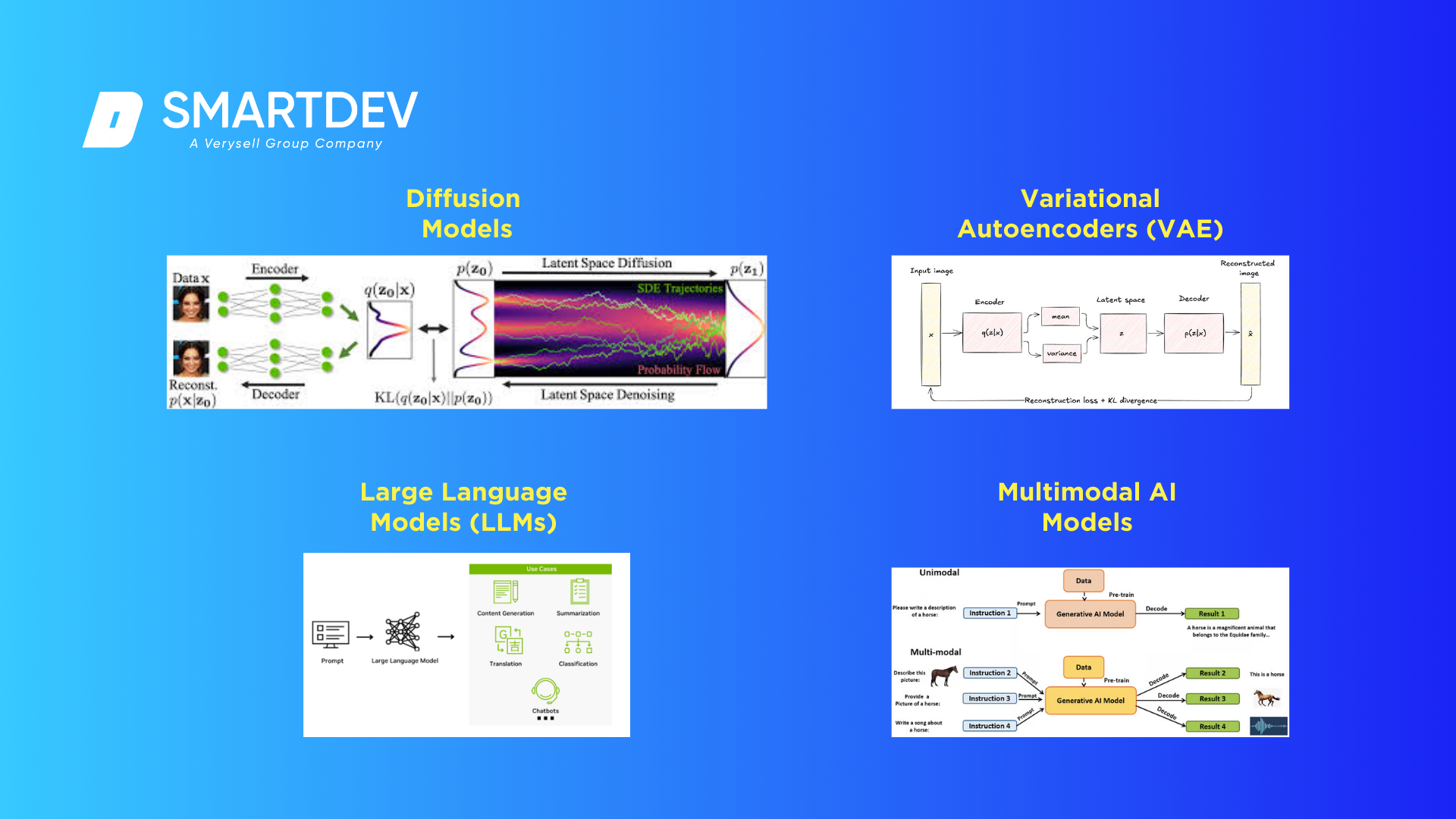 Generative AI is ushering in a new era of artificial intelligence, where models not only analyze and interpret data but also generate new, realistic data based on learned patterns. These AI model types are transforming industries like art, entertainment, and content creation by producing highly realistic outputs such as images, videos, and text.
Generative AI is ushering in a new era of artificial intelligence, where models not only analyze and interpret data but also generate new, realistic data based on learned patterns. These AI model types are transforming industries like art, entertainment, and content creation by producing highly realistic outputs such as images, videos, and text.
In this section, we explore some of the most prominent types of AI models in the generative AI space.
Diffusion Models
Diffusion models are a class of generative models that have gained attention for their ability to create highly realistic images. By gradually adding noise to an image and then reversing the process to reconstruct it, these models can generate stunning visual content. Stable Diffusion and Midjourney AI Art are popular examples that have revolutionized digital art creation, enabling anyone to generate realistic artwork based on simple text prompts. These models offer a new level of creativity and accessibility in visual arts.
Variational Autoencoders (VAE)
Variational Autoencoders (VAE) are deep learning models used for generating new data that closely resembles the input data. VAEs are particularly effective in generating realistic human faces and other complex structures. They work by encoding input data into a compressed representation and then decoding it back into the original space. This ability to recreate data with slight variations makes VAEs suitable for tasks like face generation, image reconstruction, and data augmentation.
Large Language Models (LLMs)
Large Language Models (LLMs) have brought significant advancements to natural language processing and generation. Models like OpenAI’s GPT-4 and Google Bard can generate human-like text, answer questions, and even engage in complex dialogues. These AI model types have set new benchmarks for language understanding, enabling applications such as automated content creation, customer support chatbots, and real-time translation services. Their ability to generate coherent, context-aware text has been transformative for industries reliant on written communication.
Multimodal AI Models
Multimodal AI models represent a leap forward by combining different types of data, such as text and images, to generate outputs that bridge these modalities. Gemini AI and GPT-4V are examples of models that can generate both text and images, enabling richer, more interactive content. These models are used in applications such as creative design, virtual assistants, and interactive media, where the ability to process and generate multiple forms of data simultaneously opens up new possibilities for user engagement and content creation.
Generative AI model types are reshaping how we create, interact with, and consume digital content. Whether generating images, text, or multimodal outputs, these models are providing new tools for artists, businesses, and innovators, marking the dawn of a new era in artificial intelligence.
Hybrid AI Models
 Hybrid AI models combine different AI techniques to improve performance and address complex challenges that single-method approaches might struggle to solve. By blending the strengths of various AI model types, hybrid models enable more powerful, adaptable, and efficient solutions.
Hybrid AI models combine different AI techniques to improve performance and address complex challenges that single-method approaches might struggle to solve. By blending the strengths of various AI model types, hybrid models enable more powerful, adaptable, and efficient solutions.
These models represent an advanced approach to artificial intelligence, incorporating diverse capabilities to meet real-world needs.
In this section, we explore some of the most impactful types of AI models in the hybrid AI landscape.
Neuro-Symbolic AI
Neuro-Symbolic AI is a hybrid AI model type that combines the flexibility of neural networks with the interpretability of symbolic reasoning. This integration allows models to perform tasks that require both learning from data and reasoning with logic, similar to how humans think. For example, Neuro-Symbolic AI can be used to reason like humans, processing complex information and drawing conclusions that involve both learned knowledge and structured rules. This model is particularly useful in tasks like knowledge representation, where understanding relationships between concepts is crucial.
AI + Blockchain
AI and blockchain technologies are increasingly being integrated to create more secure, transparent, and decentralized AI systems. By combining AI’s predictive power with blockchain’s ability to ensure trust and accountability, AI + Blockchain models offer enhanced decision-making capabilities. For instance, in secure and transparent AI decision-making, blockchain ensures that all actions and data changes within an AI system are recorded immutably, making the system more trustworthy and reducing the risk of bias or fraud. This integration is being explored in industries like finance, supply chain management, and healthcare.
AI + Edge Computing
AI + Edge Computing is a hybrid model that enables AI processing to occur closer to the data source, on devices such as smartphones, sensors, or IoT devices, rather than relying on centralized cloud servers. This AI model type is ideal for applications like AI-powered IoT devices, where real-time decision-making is required, and latency or bandwidth limitations are a concern. By processing data locally, these systems can operate more efficiently and respond faster, making them invaluable in applications like autonomous vehicles, smart cities, and healthcare monitoring.
Hybrid AI models combine the best of multiple technologies to create more robust, scalable, and efficient solutions. Whether it’s by adding reasoning capabilities, ensuring transparency, or reducing latency, these AI model types are pushing the boundaries of what artificial intelligence can achieve in real-world applications.
Real-World Applications of AI Models
AI models are transforming industries across the globe by automating tasks, enhancing decision-making, and solving complex problems. From healthcare to entertainment, these AI model types are providing innovative solutions that were once thought to be unattainable.
In this section, we explore how AI is applied in various sectors, revolutionizing processes and creating new opportunities.
Healthcare

Source: Artificial intelligence in clinical medicine: catalyzing a sustainable global healthcare paradigm – Frontier
In healthcare, AI models are playing a pivotal role in improving medical diagnostics and advancing drug discovery. AI-powered tools can analyze medical images, such as X-rays and MRIs, to assist doctors in diagnosing diseases more accurately and quickly.
Furthermore, AI models are accelerating drug discovery by predicting how molecules will interact, significantly reducing the time and cost associated with bringing new drugs to market. These advancements are helping improve patient outcomes and streamline healthcare operations.
Finance
AI models are extensively used in the finance industry for fraud detection and risk assessment. Machine learning algorithms can analyze transaction data in real-time to detect unusual patterns, flagging potential fraudulent activity.
In risk assessment, AI models evaluate large volumes of financial data to predict market trends, assess credit risk, and inform investment decisions. By automating these processes, AI is enhancing security, reducing human error, and improving financial decision-making.
Retail & E-commerce
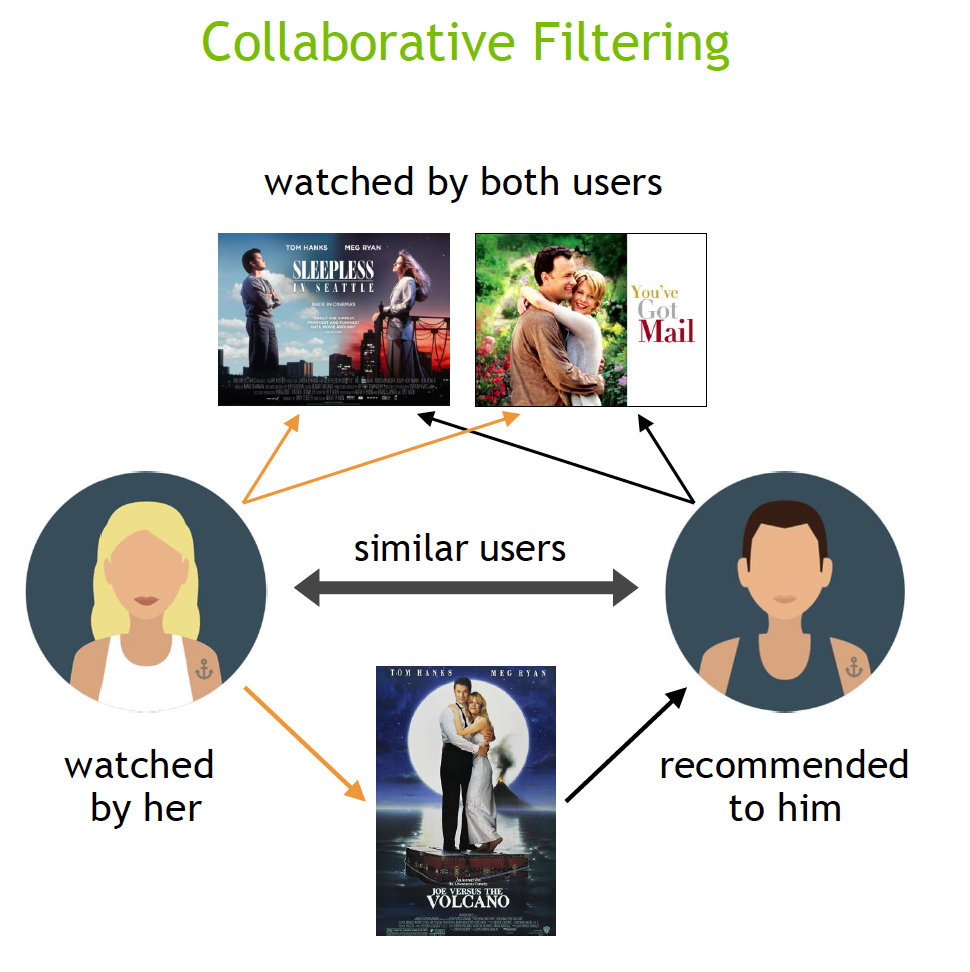
Source: What is a Recommendation System? | Data Science – NVDIA
In the retail and e-commerce sectors, AI models are widely used for recommendation engines. These models analyze customer behavior, purchase history, and preferences to suggest products that a customer is likely to buy.
Companies like Amazon and Netflix use these models to personalize shopping experiences, increase sales, and enhance customer satisfaction. Additionally, AI-powered chatbots are helping retailers improve customer service by offering real-time assistance and support.
Manufacturing
AI is also transforming manufacturing through AI-driven automation and predictive maintenance. AI models enable robots and automated systems to perform tasks such as assembly, inspection, and quality control with high precision and efficiency. Predictive maintenance models analyze sensor data from equipment to predict when machines are likely to fail, helping manufacturers minimize downtime and reduce maintenance costs. These applications are improving productivity and operational efficiency in manufacturing plants.
Entertainment
In the entertainment industry, AI is revolutionizing content creation and gaming. AI models are used to generate music, art, and even entire scripts, enhancing creative processes. In gaming, AI-driven algorithms power realistic NPC behavior, procedural content generation, and dynamic difficulty adjustments, making games more engaging and immersive. AI is also enhancing personalized experiences, where platforms like Spotify and YouTube use algorithms to recommend content tailored to users’ preferences.
AI models are reshaping industries across the globe, enabling smarter decision-making, improving efficiency, and creating new opportunities for innovation. These real-world applications highlight the vast potential of AI model types in solving complex problems and enhancing everyday experiences.
Challenges and Limitations of AI Models
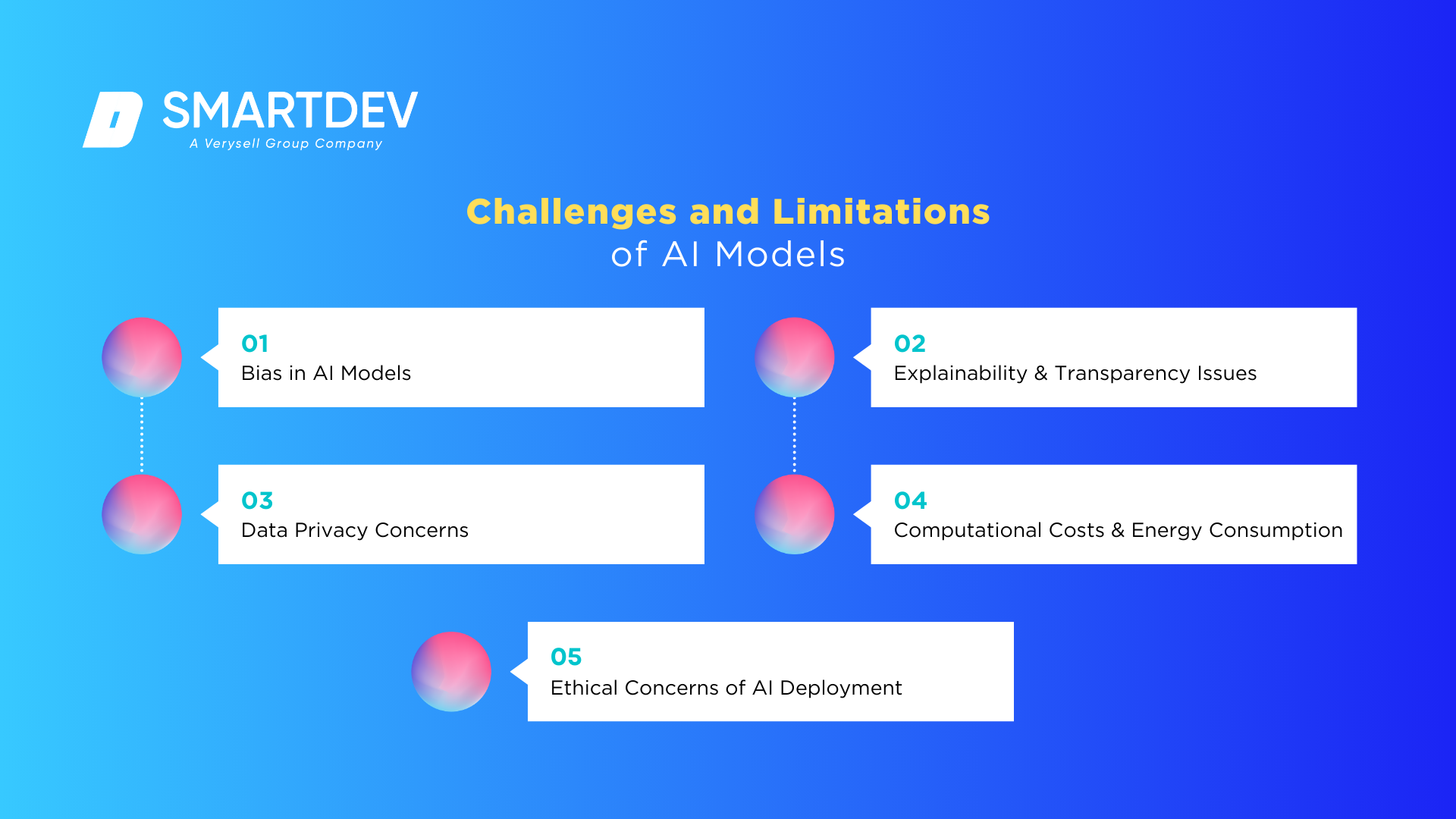 Despite the significant advancements AI models have brought to various industries, there are several challenges and limitations that need to be addressed for their effective and ethical deployment. From bias and data privacy concerns to the high computational costs of AI systems, these challenges highlight the complexities of AI model development and implementation.
Despite the significant advancements AI models have brought to various industries, there are several challenges and limitations that need to be addressed for their effective and ethical deployment. From bias and data privacy concerns to the high computational costs of AI systems, these challenges highlight the complexities of AI model development and implementation.
In this section, we explore some of the key issues facing AI model types and their applications.
Bias in AI Models
One of the most prominent challenges with AI model types is bias. AI models can inadvertently perpetuate existing biases present in training data, leading to unfair or discriminatory outcomes. For instance, facial recognition models have been shown to exhibit bias towards certain demographic groups, resulting in inaccuracies and potential harm.
Addressing bias requires careful data curation, ongoing monitoring, and the development of algorithms that can detect and correct biased patterns, ensuring that AI models make equitable and fair decisions.
Explainability & Transparency Issues
Another challenge is the explainability and transparency of AI models, particularly deep learning models, which are often referred to as “black boxes.” These models can make highly accurate predictions, but understanding the reasoning behind their decisions can be difficult. This lack of transparency raises concerns, especially in high-stakes applications like healthcare and finance, where users need to trust AI-generated recommendations.
Improving explainability involves developing techniques such as explainable AI (XAI), which aims to make AI models more interpretable and transparent to users.
Data Privacy Concerns
As AI models rely on vast amounts of data, data privacy becomes a significant concern. Personal data, especially sensitive information, is often required for training models in fields like healthcare, finance, and marketing.
However, there is a growing concern over how this data is collected, stored, and used. Without proper safeguards, AI models could compromise individual privacy or expose users to data breaches. Adhering to strict data protection laws, such as GDPR, and implementing robust security measures are essential steps in addressing privacy issues.
Computational Costs & Energy Consumption
AI models, particularly deep learning models, can be highly computationally intensive, requiring substantial processing power and energy. This raises concerns about the environmental impact of training large models and the financial cost of maintaining AI systems.
The energy consumption associated with AI model training and inference is a challenge that the industry must address, potentially through more energy-efficient algorithms or utilizing renewable energy sources for data centers.
Ethical Concerns of AI Deployment
Finally, ethical concerns around the deployment of AI models are a significant limitation. As AI systems become more integrated into daily life, questions arise about their impact on society, such as the potential for job displacement, the risk of misuse in surveillance, or the ethics of AI in military applications. These issues require careful consideration of ethical principles and the development of regulatory frameworks to guide the responsible use of AI technologies.
While AI model types offer immense potential, addressing these challenges is critical to ensuring that AI is used safely, fairly, and ethically. Efforts to mitigate bias, enhance transparency, protect privacy, reduce energy consumption, and navigate ethical issues will be essential in advancing AI technology for the benefit of society.
Future Trends in AI Models
As AI continues to evolve, several emerging trends are shaping the future of AI model types. From the pursuit of General AI to the integration of quantum computing, the next generation of AI promises to be more advanced, efficient, and capable of solving even more complex challenges. In this section, we explore the key future trends in AI models that are poised to revolutionize the field.
The Rise of General AI (AGI)
One of the most anticipated developments in AI is the rise of General AI or AGI (Artificial General Intelligence). Unlike current AI model types, which are designed for specific tasks, AGI would be capable of performing any intellectual task that a human can do.
The pursuit of AGI represents the ultimate goal in artificial intelligence research, as it would enable machines to reason, learn, and understand in a manner similar to human cognition. While AGI is still theoretical and far from realization, it is seen as the next major leap in AI development, with the potential to transform industries and society as a whole.
AI Models That Learn with Less Data
Another promising trend is the development of AI models that learn with less data. Current AI systems require vast amounts of labeled data to be trained effectively.
However, there is growing interest in creating models that can perform well with minimal data, often referred to as few-shot learning or one-shot learning. These models can make accurate predictions or decisions even with limited training examples, which could drastically reduce the time and cost associated with gathering and labeling large datasets. This advancement could make AI more accessible and adaptable across a wider range of applications.
AI & Quantum Computing
AI and quantum computing are two fields that are rapidly advancing in parallel. Quantum computing holds the potential to vastly increase computational power, enabling the processing of much larger datasets and more complex AI models than are possible with classical computers.
When integrated with AI, quantum computing could lead to breakthroughs in areas like drug discovery, optimization problems, and climate modeling. While quantum computing is still in its early stages, the combination of these technologies promises to unlock unprecedented capabilities for AI models in the near future.
Regulation and Governance in AI
As AI becomes more integral to society, regulation and governance are becoming increasingly important. Governments and organizations are beginning to focus on creating frameworks to ensure that AI models are developed and deployed ethically, safely, and transparently. This includes addressing concerns like data privacy, bias, and accountability.
Regulatory bodies may implement standards to ensure AI is used responsibly, guiding the development of trustworthy AI models and fostering public confidence. The evolution of AI regulations will be crucial in balancing innovation with ethical considerations, ensuring that AI technologies benefit society as a whole.
The future of AI model types is filled with exciting possibilities, from the advent of AGI to the integration of quantum computing. As AI continues to advance, it will bring both new opportunities and challenges, making it essential to carefully navigate its development and deployment.
Choosing the Right Type of AI Model for Your Needs
As artificial intelligence continues to evolve, selecting the right AI model type for your specific needs has become a crucial step in harnessing its full potential. With a wide variety of AI model types available, from supervised learning to generative AI, understanding which model best aligns with your goals is key to achieving successful outcomes.
This section provides an AI model selection guide, helps future-proof your AI strategy, and offers a call to action for leveraging AI solutions from SmartDev.
AI Model Selection Guide
Choosing the right AI model requires a clear understanding of your objectives, data requirements, and the specific challenges you aim to solve.
Start by identifying the type of problem you’re dealing with—whether it’s a classification, prediction, or optimization task.
For problems with labeled data, supervised learning models such as decision trees or neural networks may be ideal.
If you’re working with unstructured data or looking to uncover hidden patterns, consider unsupervised learning models like clustering or dimensionality reduction techniques. For dynamic, decision-making environments, reinforcement learning models could be the solution.
Understanding these distinctions will help you choose the best model to achieve your business goals efficiently.
Future-proofing Your AI Strategy
To future-proof your AI strategy, it’s essential to consider the rapid advancements in AI technologies and anticipate the need for scalability and flexibility. Keep an eye on emerging trends such as General AI, quantum computing, and AI models that learn with less data.
Ensure that your AI infrastructure can handle the integration of newer models as they emerge. It’s also important to build a framework for ethical AI deployment and stay compliant with evolving regulations. By embracing a long-term perspective and being adaptable, you can future-proof your AI investments and remain competitive in the ever-evolving AI landscape.
At SmartDev, we specialize in helping businesses choose and implement the most appropriate AI model types for their needs. Whether you’re looking to develop a custom AI solution or integrate existing models into your operations, our team of experts can guide you through the selection process and ensure that your AI strategy aligns with your objectives.
Contact us today to discuss how we can help you leverage AI to drive innovation, optimize processes, and achieve business success. Let us assist you in building the AI-driven future you envision.
—
References:
-
IBM. “What is an AI Model.” IBM Blog. .
-
Towards Data Science. “How AI Models Work.” Towards Data Science.
-
Microsoft. “AI vs. Machine Learning vs. Deep Learning.” Microsoft Blog. https://blog.microsoft.com/ai-vs-machine-learning-vs-deep-learning/.
-
IBM. “AI and Blockchain: What is AI and Blockchain.” IBM Blockchain.
-
Towards Data Science. “What is Generative AI and How Does it Work.” Towards Data Science.
-
GeeksforGeeks. (n.d.). Illustrations. Retrieved from https://www.geeksforgeeks.org/
- NVIDIA. (n.d.). Illustrations. Retrieved from https://www.nvidia.com/
- Spiceworks. (n.d.). Illustrations. Retrieved from https://www.spiceworks.com/
- Simplilearn. (n.d.). Illustrations. Retrieved from https://www.simplilearn.com/
- Innovatics. (n.d.). Illustrations. Retrieved from https://www.innovatics.com/
- DataCamp. (n.d.). Illustrations. Retrieved from https://www.datacamp.com/







